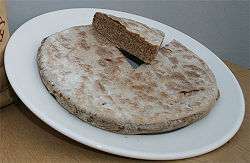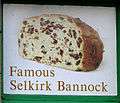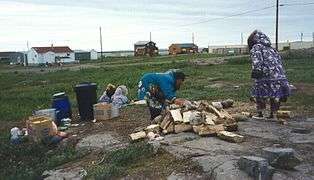Bannock (food)
 Traditional beremeal bannock, as made in Orkney, Scotland. | |
| Type | Quick bread |
|---|---|
| Place of origin | British Isles |
Bannock is a variety of flat quick bread or any large, round article baked or cooked from grain. A bannock is usually cut into sections before serving.
English / Scottish
The word "bannock" comes from Northern and Scots English dialects. The Oxford English Dictionary states the term stems from panicium, a Latin word for "baked dough", or from panis, meaning bread. It was first referred to as "bannuc" in early glosses to the 8th century author Aldhelm (d. 709),[1] and its first cited definition in 1562. Its historic use was primarily in Ireland, Scotland and Northern England.[2] The Scottish poet Robert Burns mentions bannock in his Epistle to James Tennant of Glenconner, in reference to Alexander Tennant.[3]
Early history
The original bannocks were heavy, flat cakes of unleavened barley or oatmeal dough formed into a round or oval shape, then cooked on a griddle (or girdle in Scots). In Scotland, before the 19th century, bannocks were cooked on a bannock stane (Scots for stone), a large, flat, rounded piece of sandstone, placed directly onto a fire, used as a cooking surface.[4] Most modern bannocks are made with baking powder or baking soda as a leavening agent, giving them a light and airy texture.[5][6][7] There is a suggestion that bannock cakes played a pivotal role in the deciding of a person for human sacrifice during the late Iron Age in the discovery of Lindow Man.[8]
Varieties
Bannock varieties can be named or differentiated according to various characteristics: the flour or meal from which they are made, whether they are leavened or not, whether they have certain special ingredients, how they are baked or cooked, and the names of rituals or festivals in which they are used. Historically, specially made bannocks were used in rituals marking the changing of the Gaelic seasons: St Bride's bannock for spring (February 1), Bealtaine bannock for summer (May 1), Lughnasadh or Lammas bannock for autumn harvests (August 1), and Samhain bannock for winter (end of October). Other special bannocks include beremeal bannock, bride's bannock, cod liver bannock, cryin' bannock, fallaid bannock, fife bannock, Hogmanay bannock, Marymas bannock, mashlum bannock, Michaelmas bannock, pease bannock, Pitcaithly bannock, salt bannock, sautie bannock, Silverweed bannock, St Columba's bannock, teethin' bannock, Yetholm bannock, and Yule bannock.[5] Manx bonnag probably comes from the same root form as bannock and is made using similar ingredients.[9] In the north of England, bannocks are often made using pastry rather than a bread dough.
Selkirk bannock
Selkirk bannock from Scotland is well-known and named after the town in the Scottish borders where it is traditionally made. It is a spongy, buttery variety, sometimes compared to a fruitcake,[10] made from wheat flour and containing a very large quantity of raisins. The first known maker of this variety was a baker named Robbie Douglas, who opened his shop in Selkirk in 1859. When Queen Victoria visited Sir Walter Scott's granddaughter at Abbotsford she is reputed to have taken her tea with a slice of Selkirk bannock, thus ensuring that its reputation was enshrined forever.[11] Today, Selkirk bannocks are popular throughout Great Britain, and can be found at most large supermarkets.[6]
- Selkirk bannock
 An advertisement for Selkirk bannock
An advertisement for Selkirk bannock
Indigenous North Americans
Bannock, skaan (or scone), or Indian bread,[12] is found throughout North American Native cuisine, including that of the Inuit of Canada and Alaska, other Alaska Natives, the First Nations of the rest of Canada, the Native Americans in the United States, and the Métis.[12][13]
Pre-contact bannock or Scottish import?
A type of bannock, using available resources, such as flour made from maize, roots, tree sap and leavening agents, may have been produced by indigenous North Americans prior to contact with outsiders, similar to modern cornbread.[13] Some sources indicate that bannock was unknown in North America until the 1860s when it was created by the Navajo who were incarcerated at Fort Sumner,[14] while others indicate that it came from a Scottish source.[12]
Terminology
Evidence for the pre-contact history of bannock comes from the fact that most indigenous North American languages have a distinct word for bannock, such as Inuvialuk: muqpauraq[15] rather than a borrowing or calque of the English or French words.
Other languages do offer hints of European influence, however, for example Navajo: bááh dah díníilghaazhh "bread that bubbles" (i.e. in fat), where "bááh" is a borrowing from Spanish: pan for flour and yeast bread, as opposed to the older Navajo: łeesʼáán which refers to maize bread cooked in hot ashes[16] Likewise, Yup'ik alatiq comes from Russian: ола́дьи "pancakes, fritters".
Preparation
As made by Indigenous North Americans, bannock is generally prepared with white or whole wheat flour, baking powder, sugar, lard and water or milk,[15] which are combined and kneaded (possibly with spices, dried fruits or other flavouring agents added) then fried in rendered fat, vegetable oil, or shortening, baked in an oven or cooked on a stick.[13]
Political significance
Bannock is the most universal of dishes in the indigenous Canadian repertoire, and is used equally in the Arctic, Plains, Sub-arctic, and Pacific cultural areas. However, the modern recipes for bannock are clearly influenced by the government rations that were distributed on Indian reserves in the late 19th century when access to country foods (plants and animals native to the region) were restricted by the arrival of non-indigenous settlers. Such rations included the staples of the European Canadian diet at that time: wheat flour, sugar, lard, and butter; all high-calorie, low-nutrient, shelf-stable foods produced in bulk quantities and shipped long distances (together with the preservative and flavour additive, salt). These new ingredients helped indigenous people to survive the loss of access to country foods, and are now thought of by some as fully a part of indigenous identity, and even as "Indian soul food". However, for others they are a reminder of the negative impacts of colonialism, and are regarded as an imposition.[17]
Tibetan
Balep korkun is a Tibetan bannock made from barley flour and cooked on a frying pan.
See also
- Damper
- Frybread
- Thirlage ('bannock': payment of a handful of meal to a miller's servant)
- List of British breads
- List of quick breads
References
- ↑ Louis Goossens, The old English glosses of ms. Brussels, Royal Library, 1650 (Aldhelm's De laudibus virginitatis) (Brussels: Paleis der Academien, 1974), 2352.
- ↑ Simpson, John; Weiner, Edward, eds. (1989). Oxford English Dictionary, Second Edition. Clarendon Press.
- ↑ Burns, Robert. "Epistle To James Tennant Of Glenconner". The Complete Works of Robert Burns. Robert Burns Country. Retrieved 2008-10-19.
- ↑ Feilden, Rosemary (1999). "Bannock Stane at Aberdeen University's Virtual Museum". Aberdeen University. Retrieved 2009-11-12.
- 1 2 "Bannock". Practically Edible: The Web's Biggest Food Encyclopaedia. Archived from the original on 20 November 2008. Retrieved 2008-10-18.
- 1 2 Ingram, Christine; Jennie Shapter (2003). BREAD: the breads of the world and how to bake them at home. (Originally published as The World Encyclopedia of Bread and Bread Making.) London: Hermes House. p. 54. ISBN 0-681-87922-X.
- ↑ Clayton, Bernard Jr. (2003). Bernard Clayton's New Complete Book of Breads. New York: Simon & Schuster. p. 555. ISBN 0-7432-3472-3.
- ↑ Ross and Robins (1989). The Life and Death of a Druid Prince.
- ↑ "Bonnag Recipes". www.isle-of-man.com. Retrieved 2017-09-14.
- ↑ Nibble on a Selkirk Bannock
- ↑ "Selkirk Bannock". Practically Edible: The Web's Biggest Food Encyclopaedia. Archived from the original on 2009-02-27. Retrieved 2008-10-18.
- 1 2 3 Oswalt, Wendell H. (2001). This Land Was Theirs: A Study of Native Americans. Greenwood Publishing Group. ISBN 978-0-19-517514-1. Retrieved 2008-10-18.
- 1 2 3 Michael D. Blackstock. "Bannock Awareness". Government of British Columbia. Archived from the original on 1 December 2008. Retrieved 2008-10-18.
- ↑ Berzok, Linda Murray (2005). American Indian Food. Oxford University Press. ISBN 978-0-313-32989-0. Retrieved 2008-10-18.
- 1 2 "IRC Foods". Irc.inuvialuit.com. Archived from the original on 2013-12-04. Retrieved 2013-11-29.
- ↑ https://navajowotd.com/word/dah-diniilghaazh/
- ↑ https://thewalrus.ca/breaking-bread/
External links
| Wikisource has the text of a 1911 Encyclopædia Britannica article about Bannock. |
| Wikibooks Cookbook has a recipe/module on |
| Wikibooks Cookbook has a recipe/module on |
| Wikimedia Commons has media related to Frybread. |


